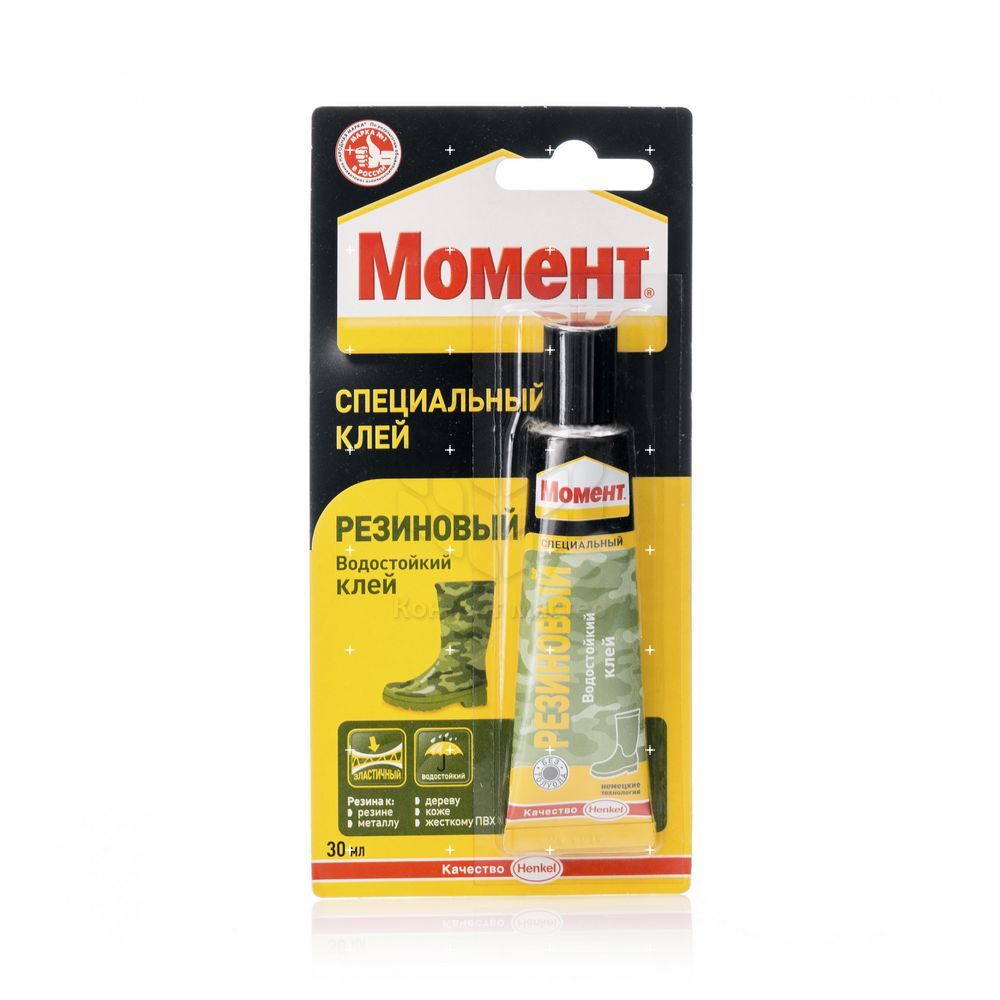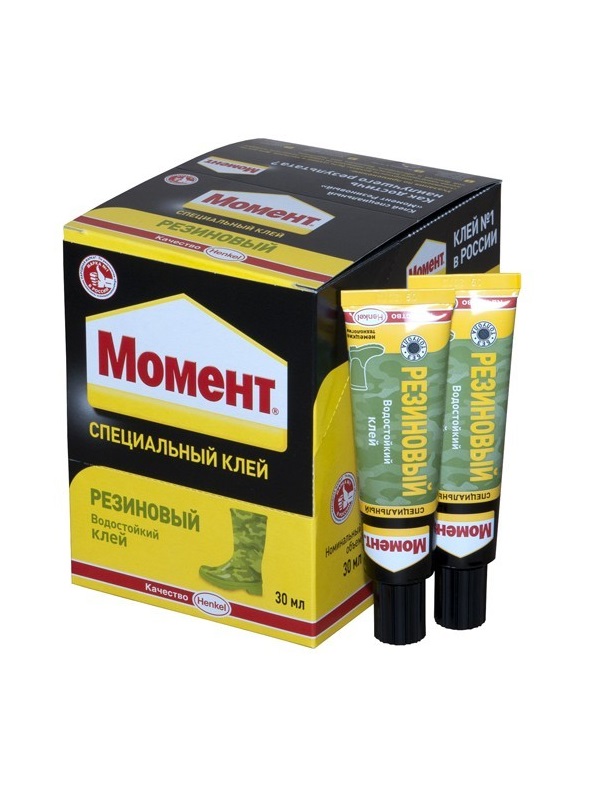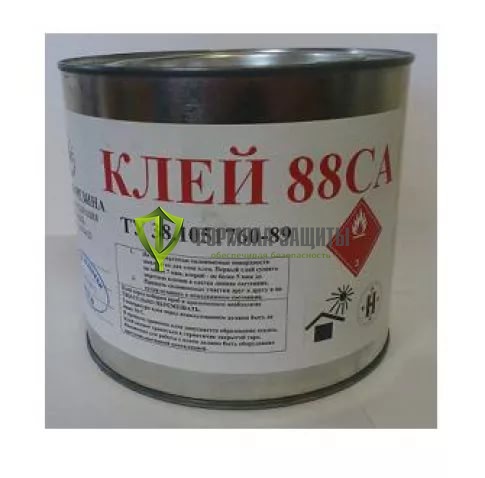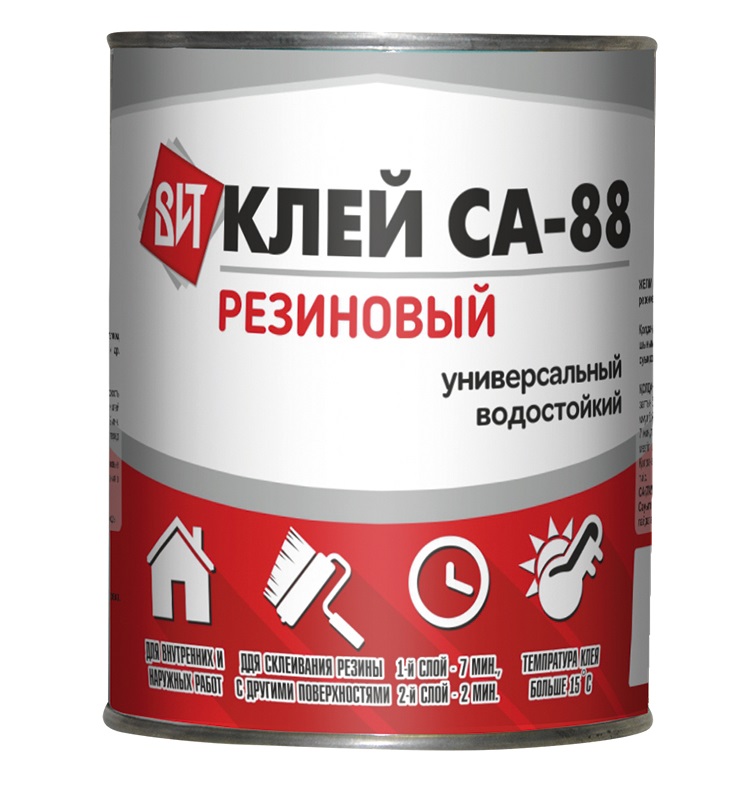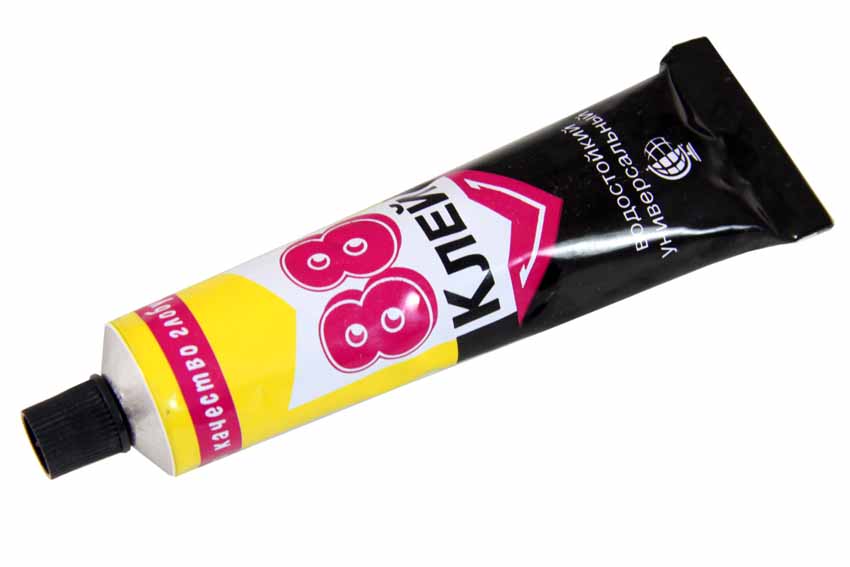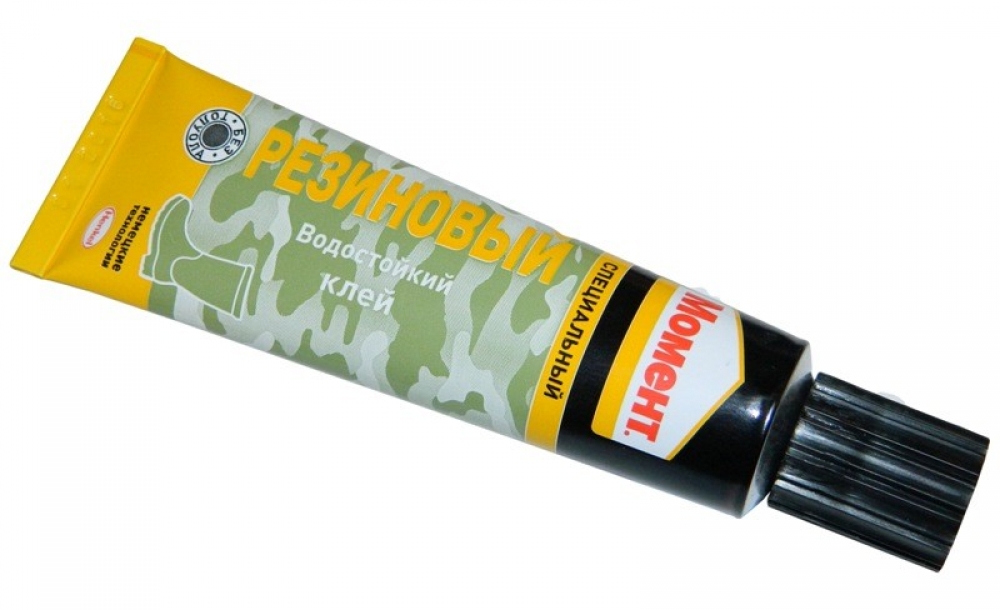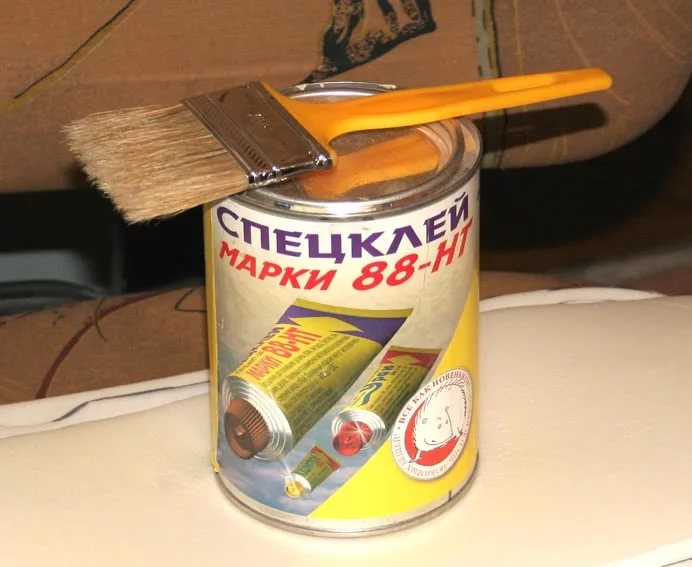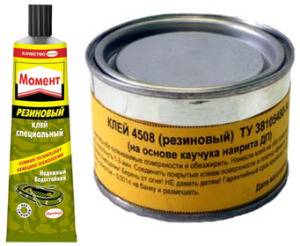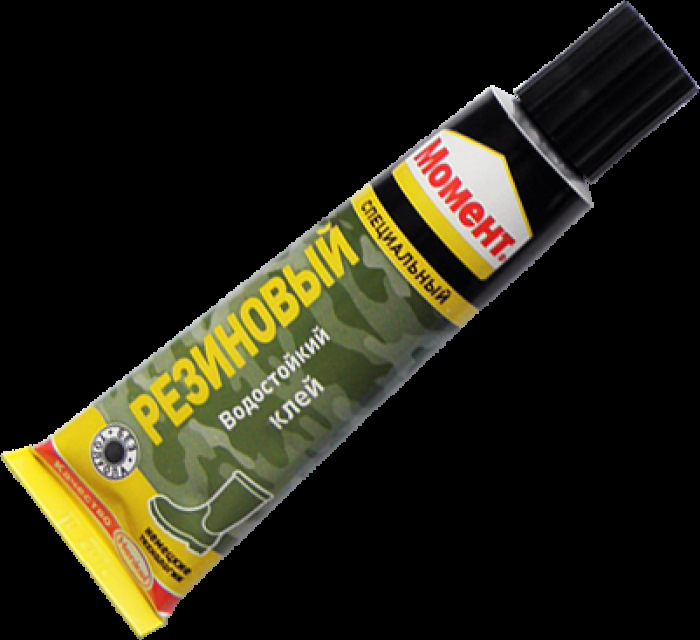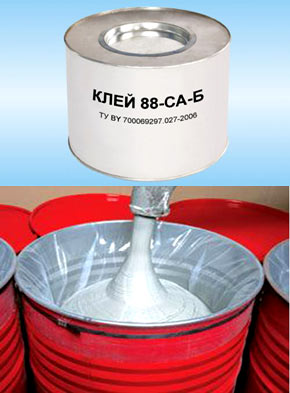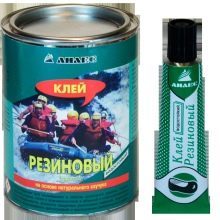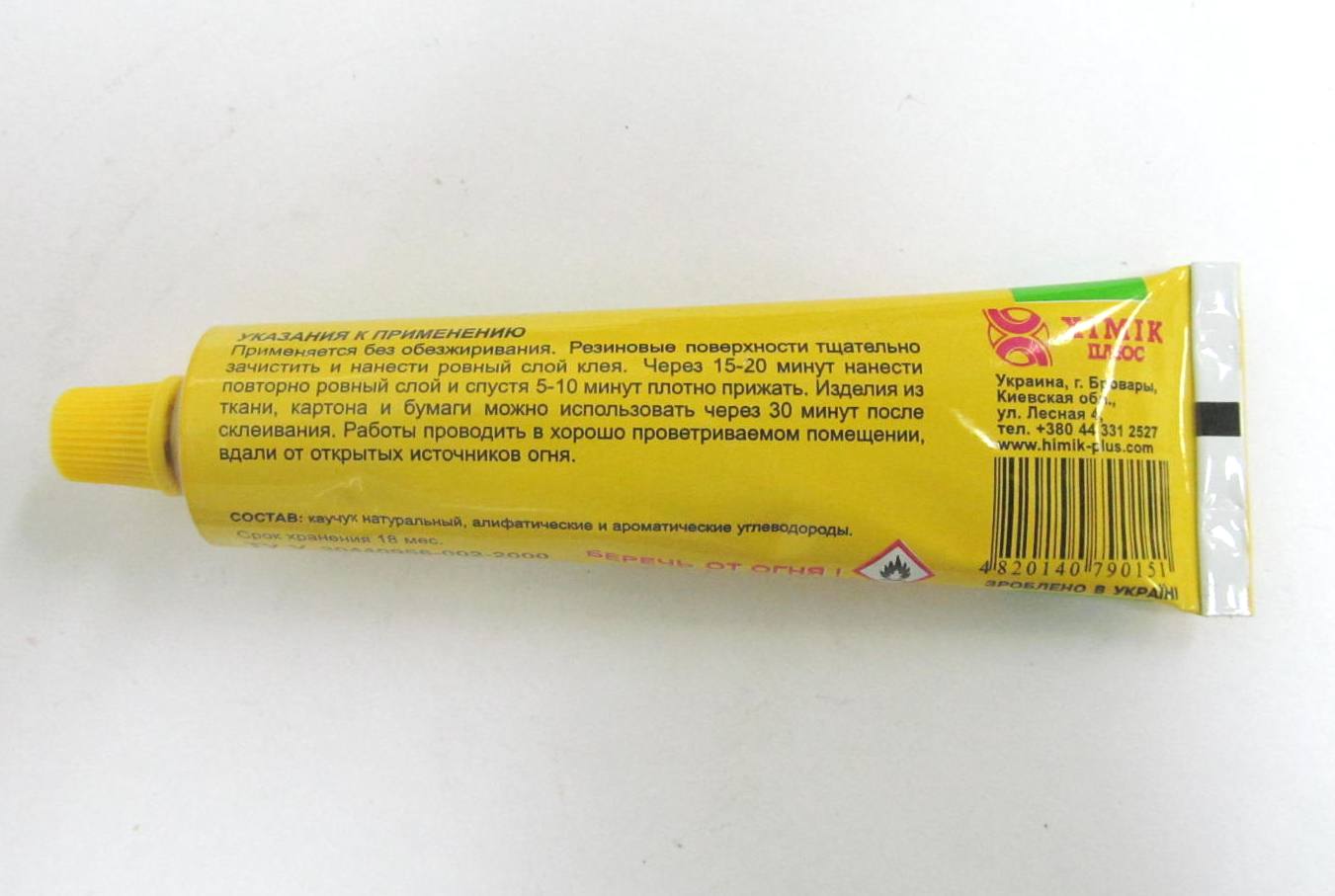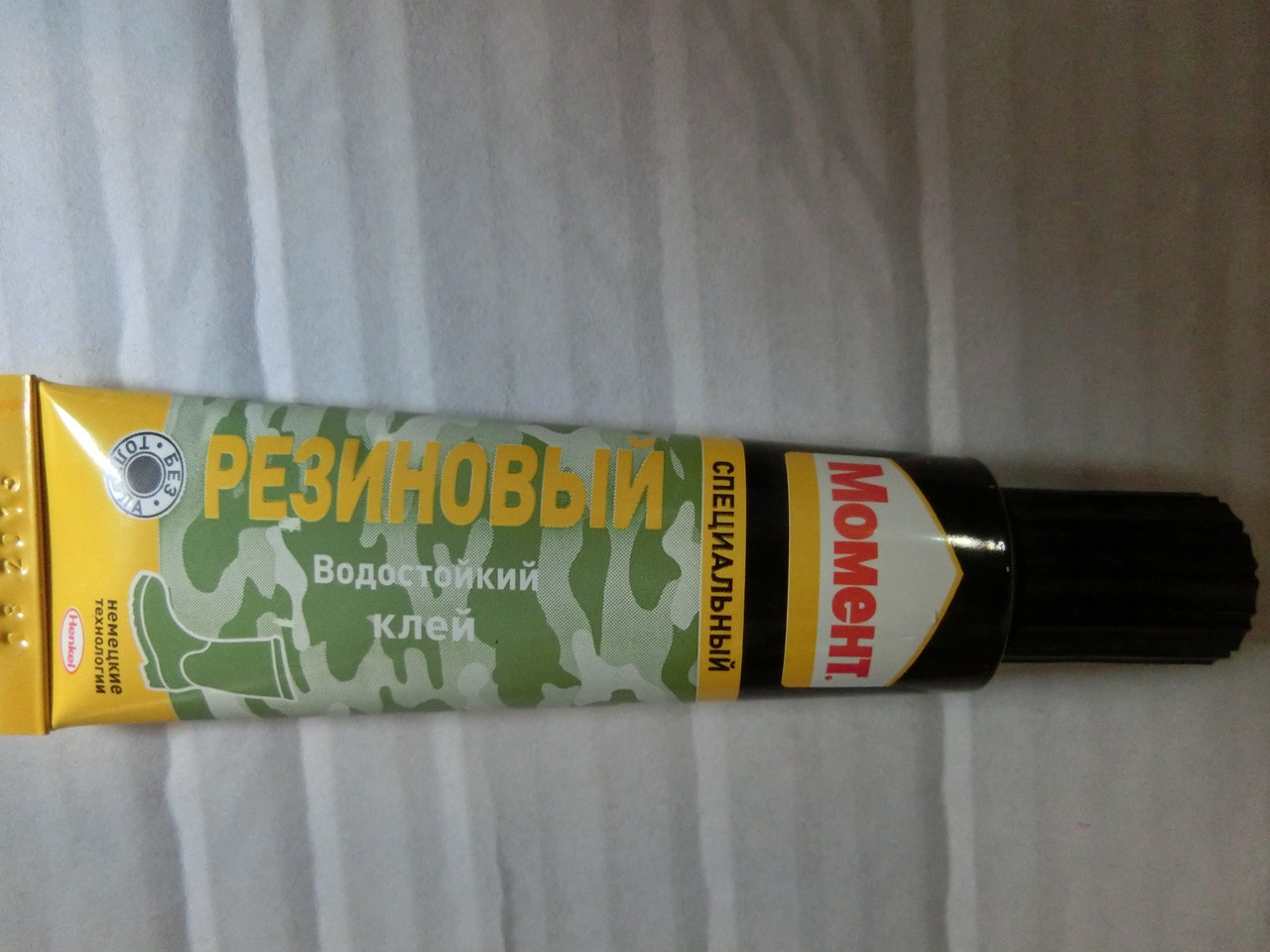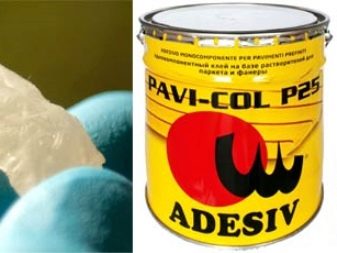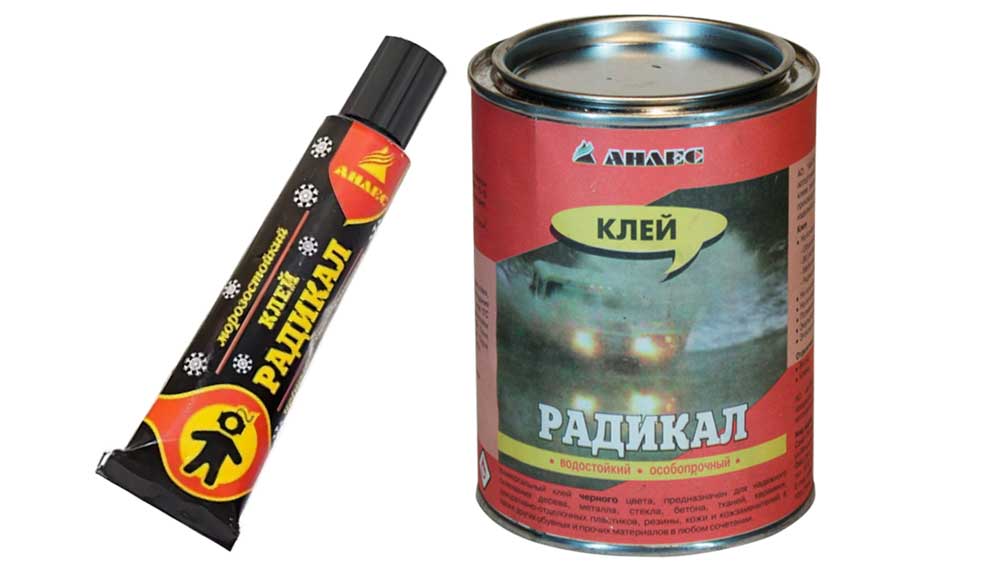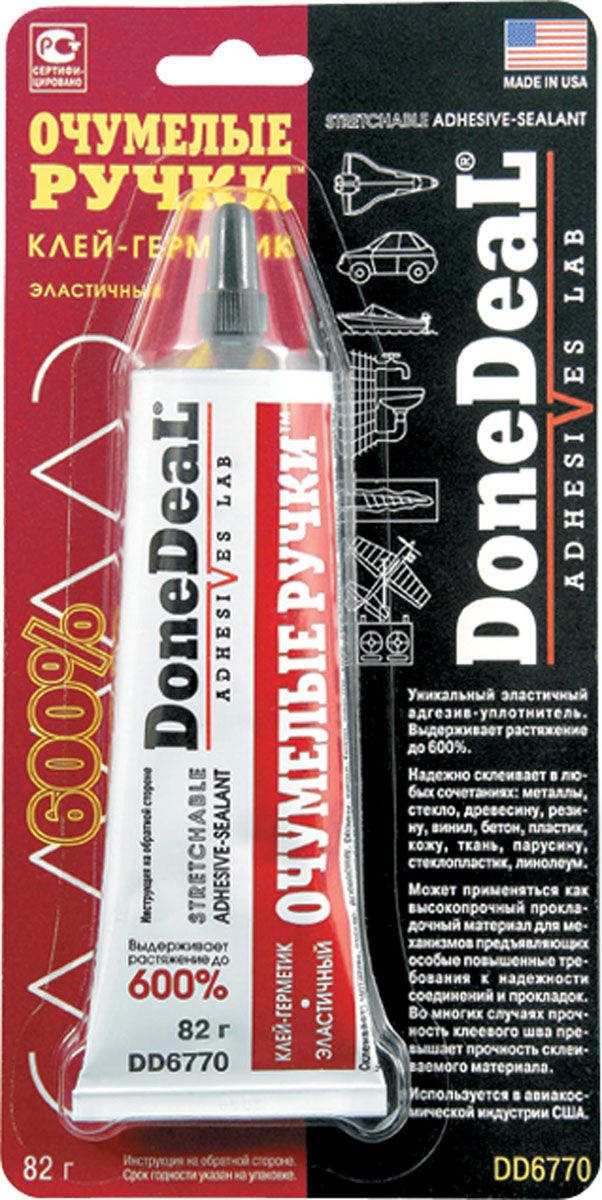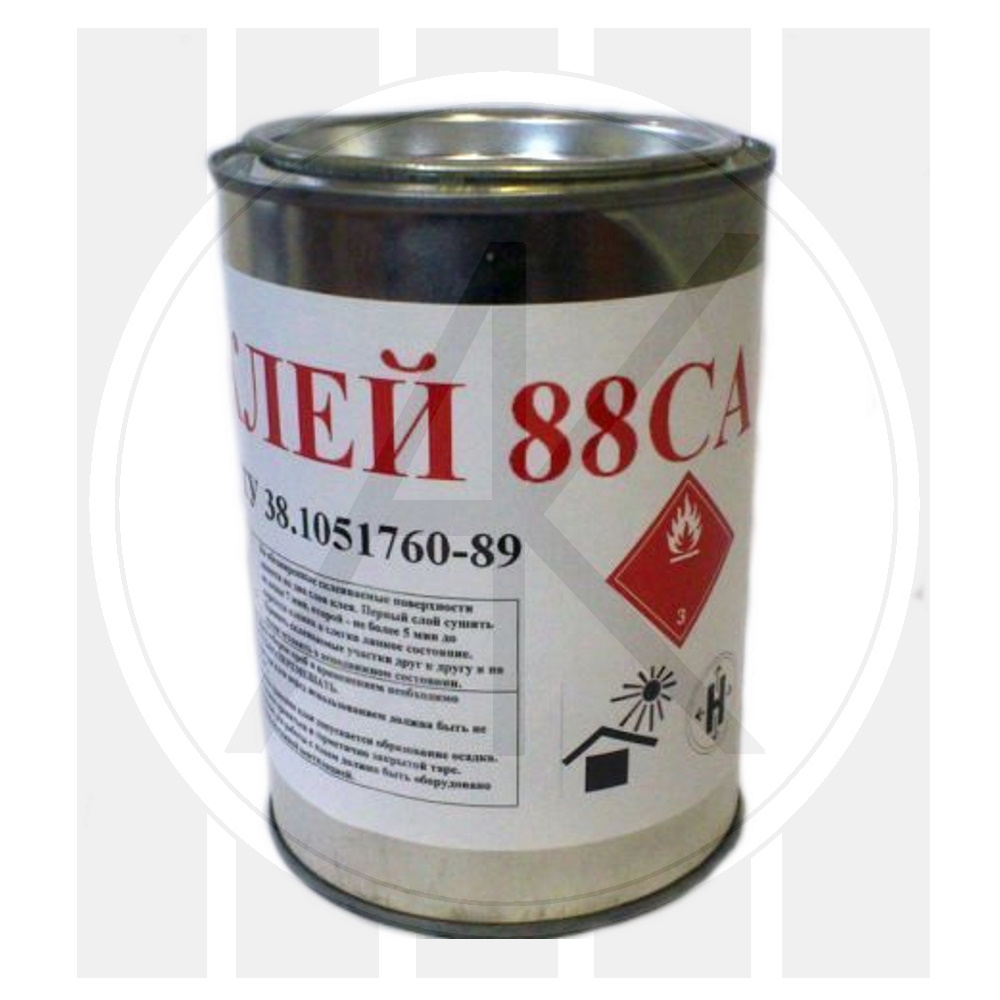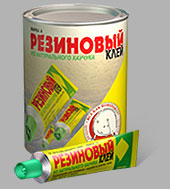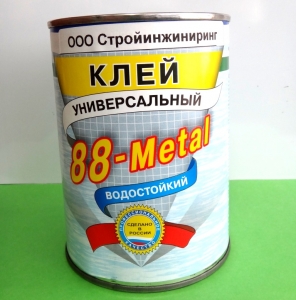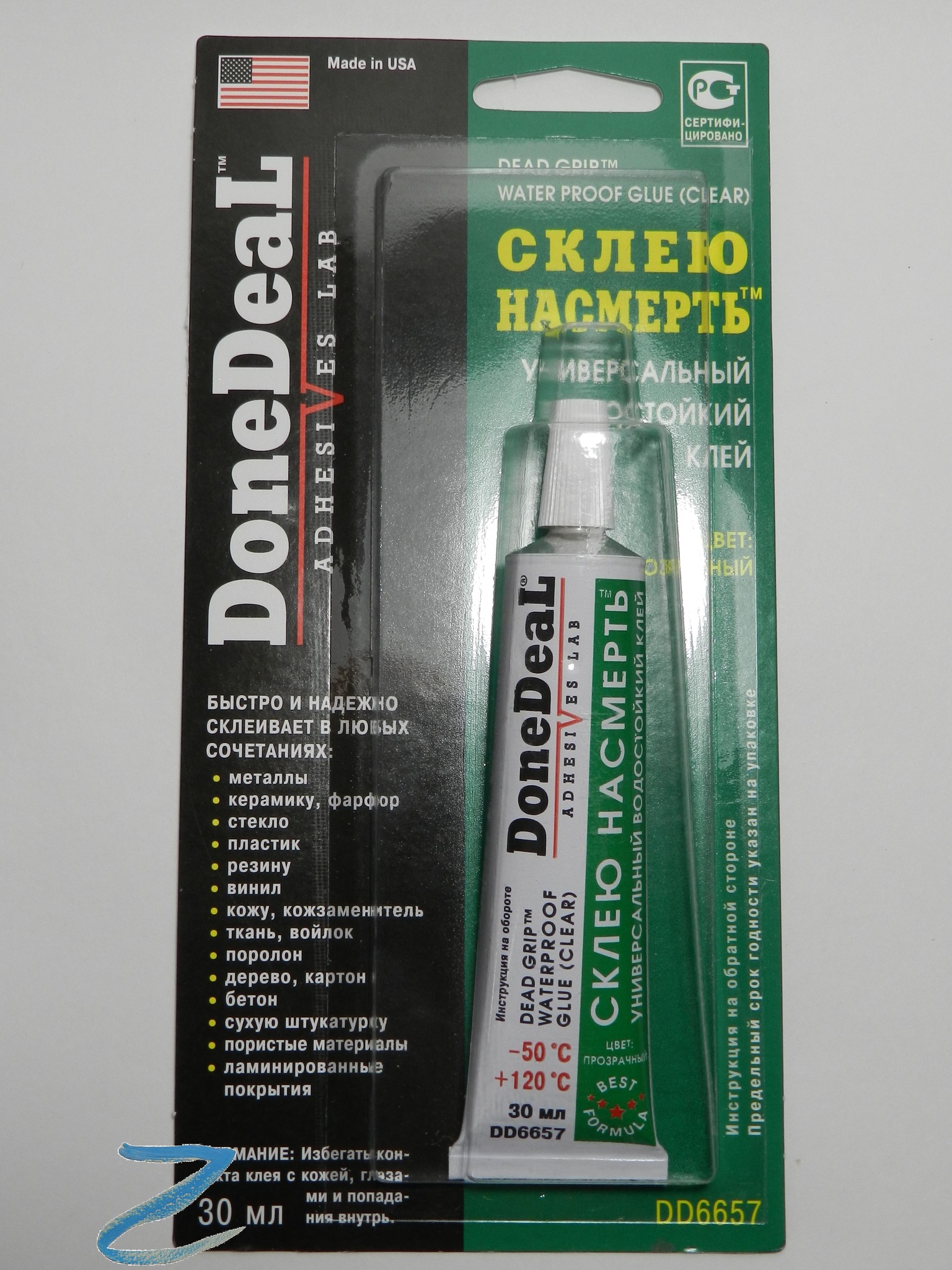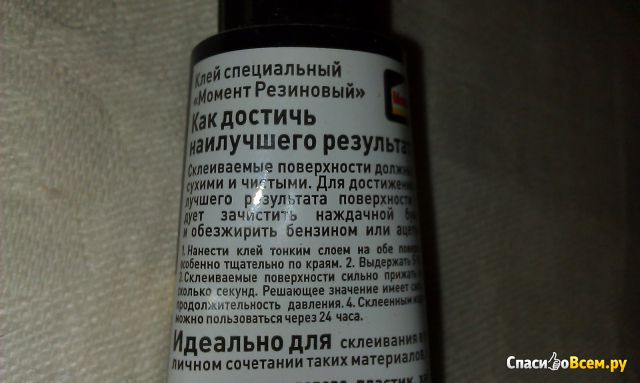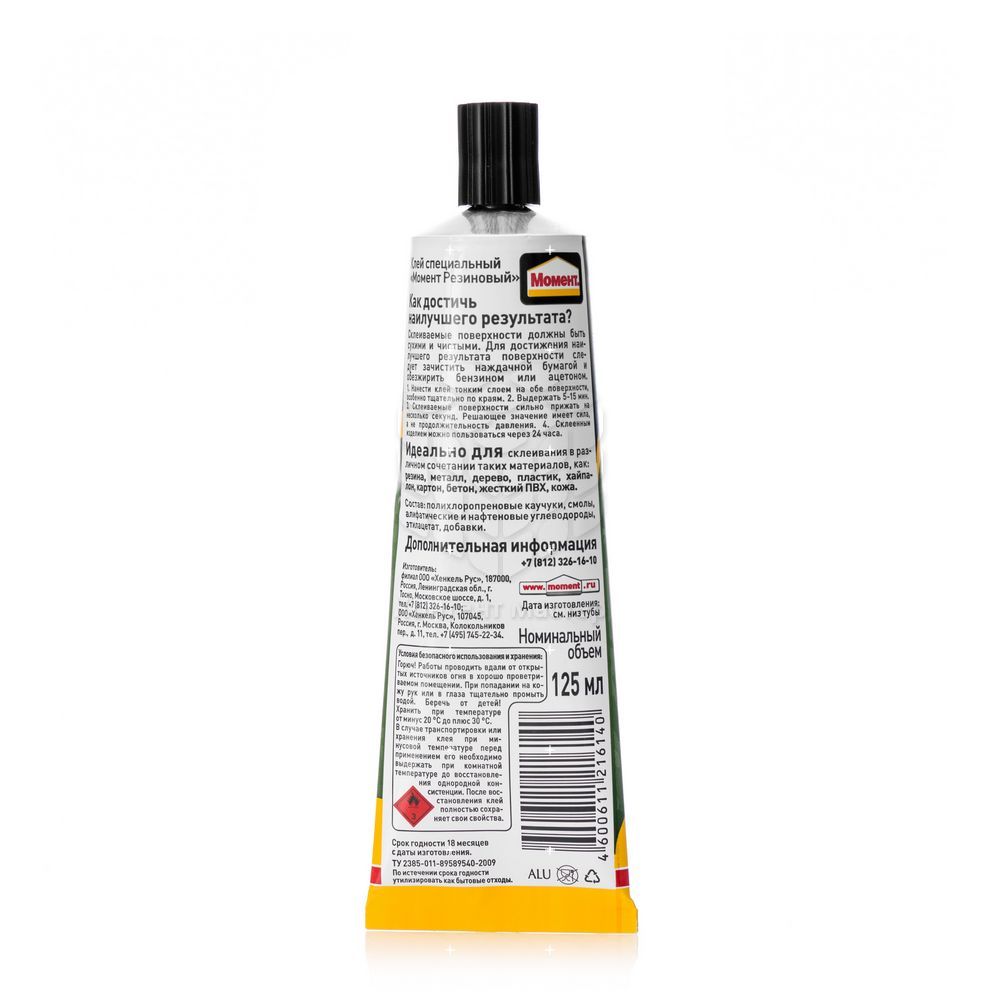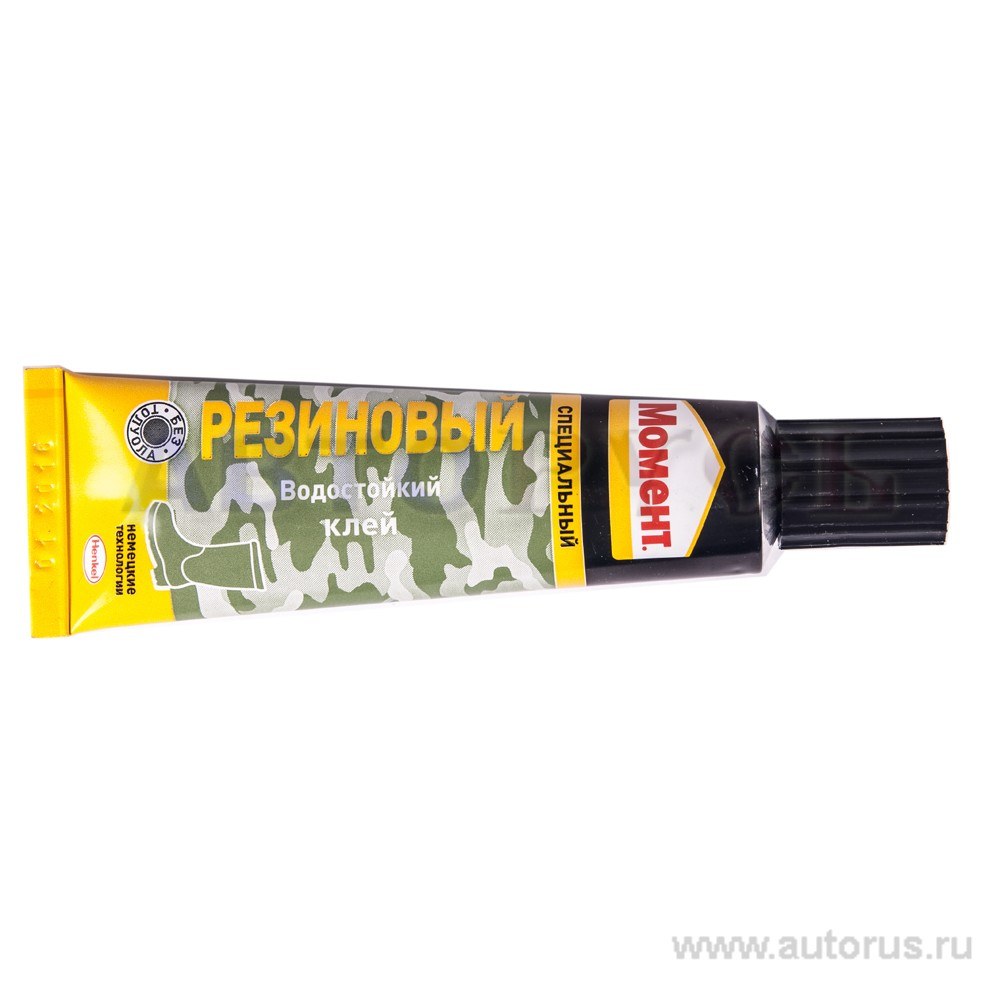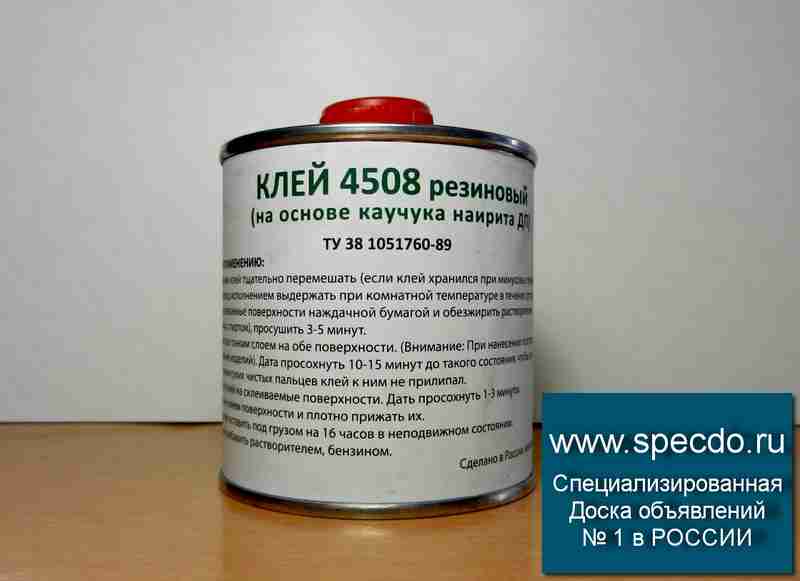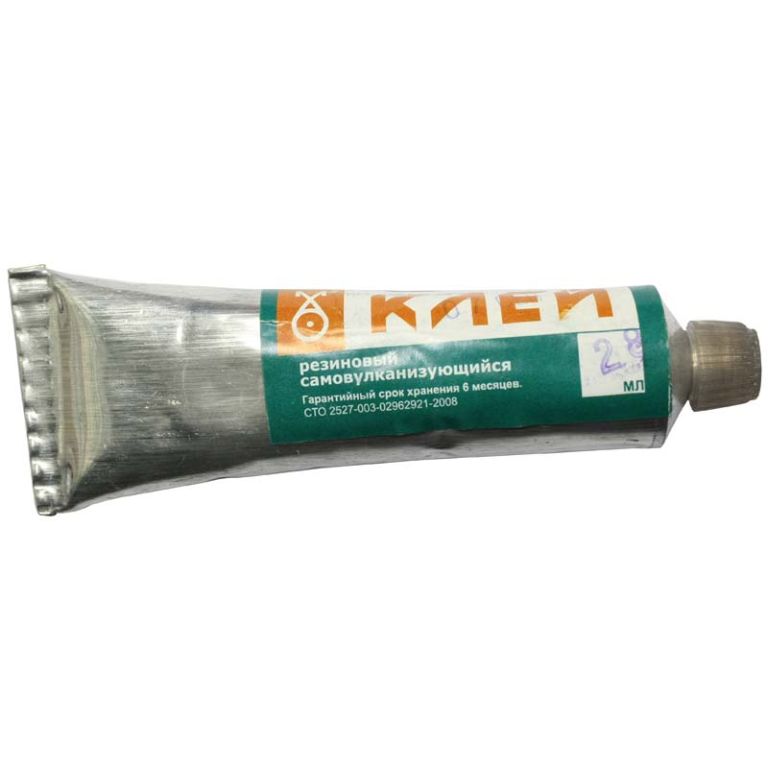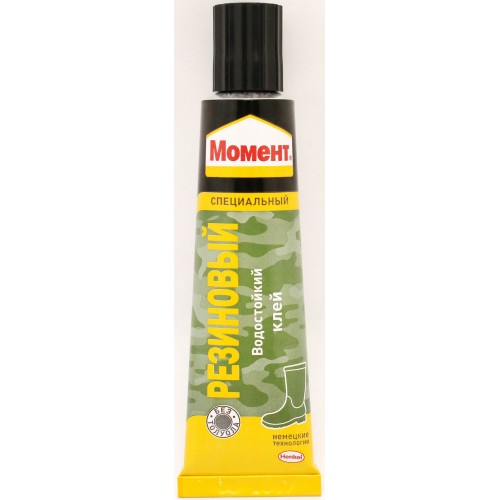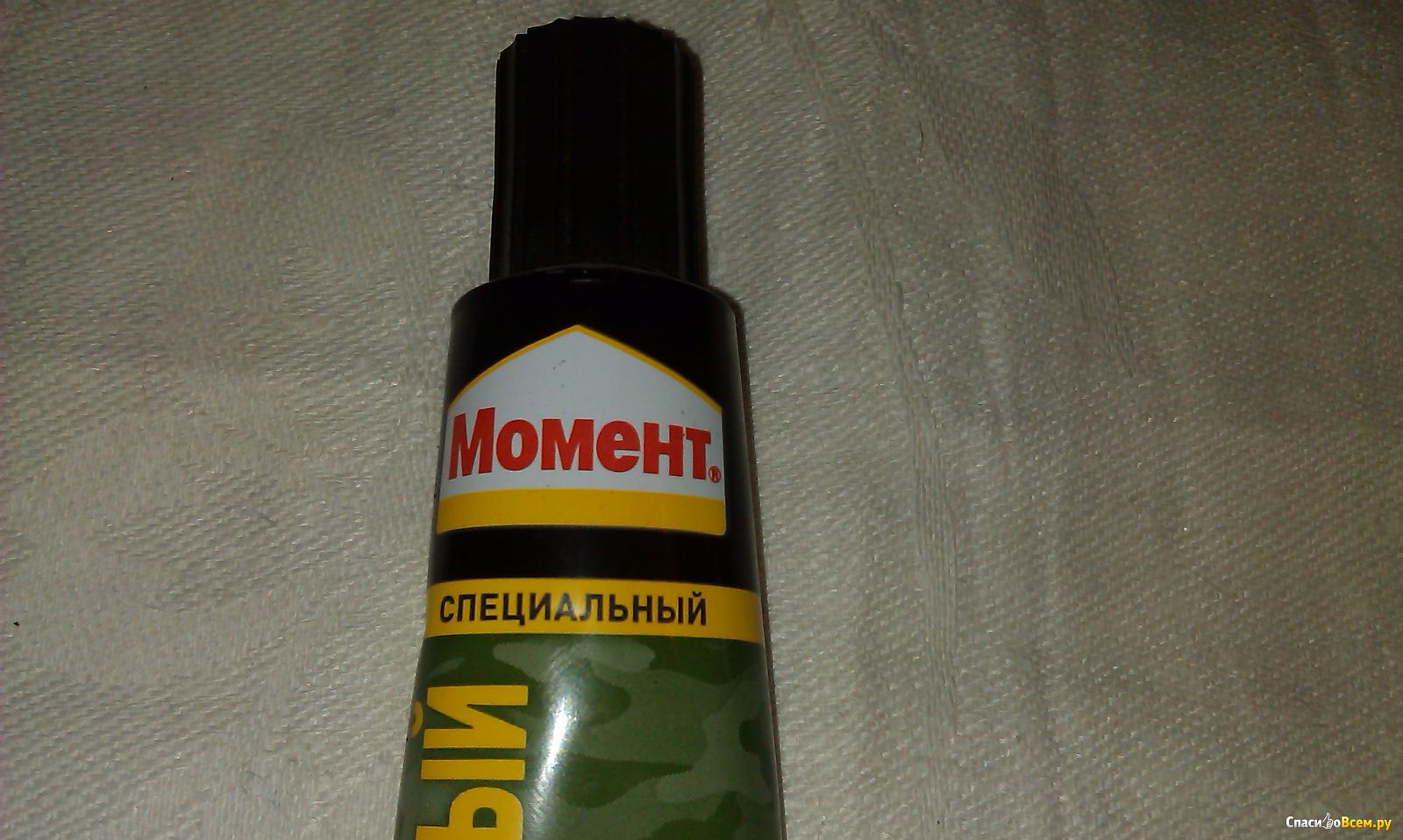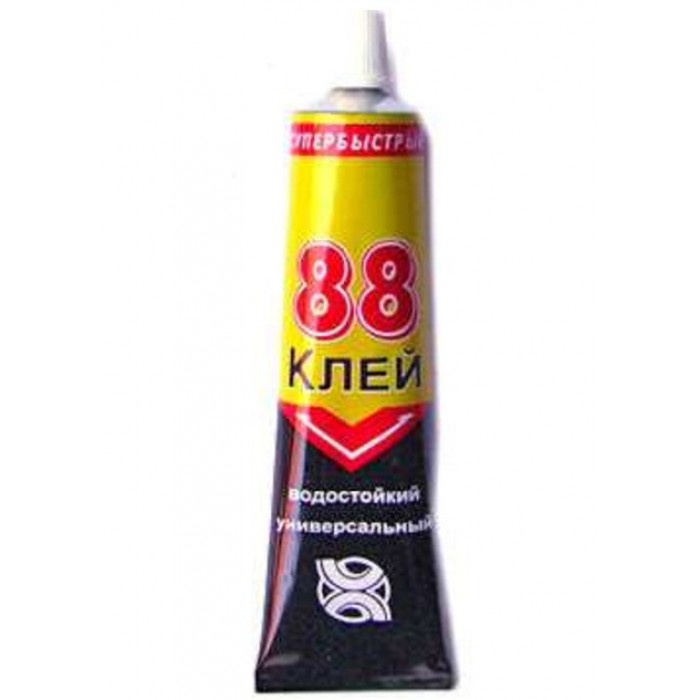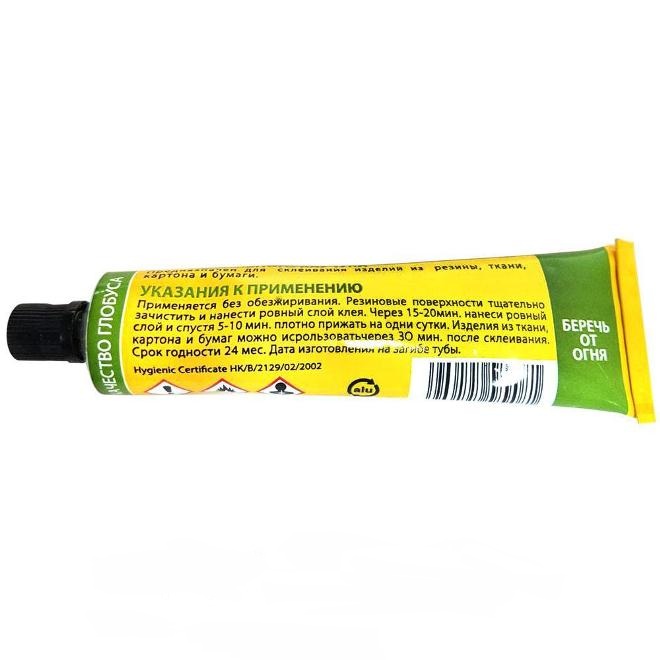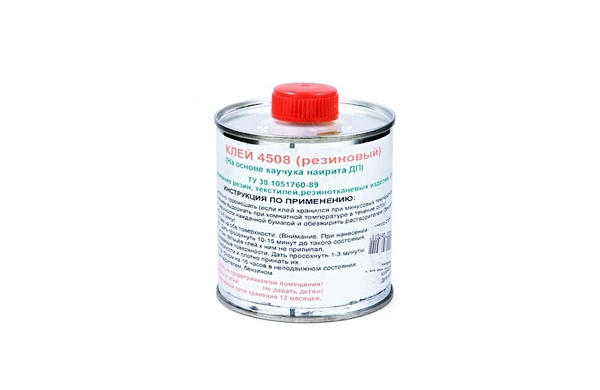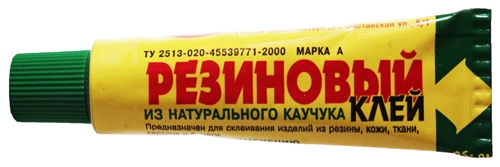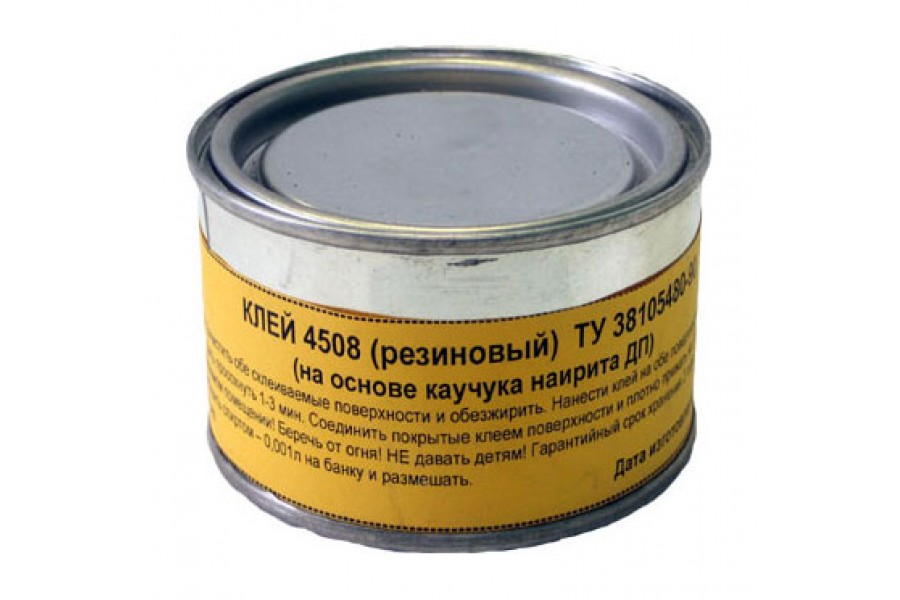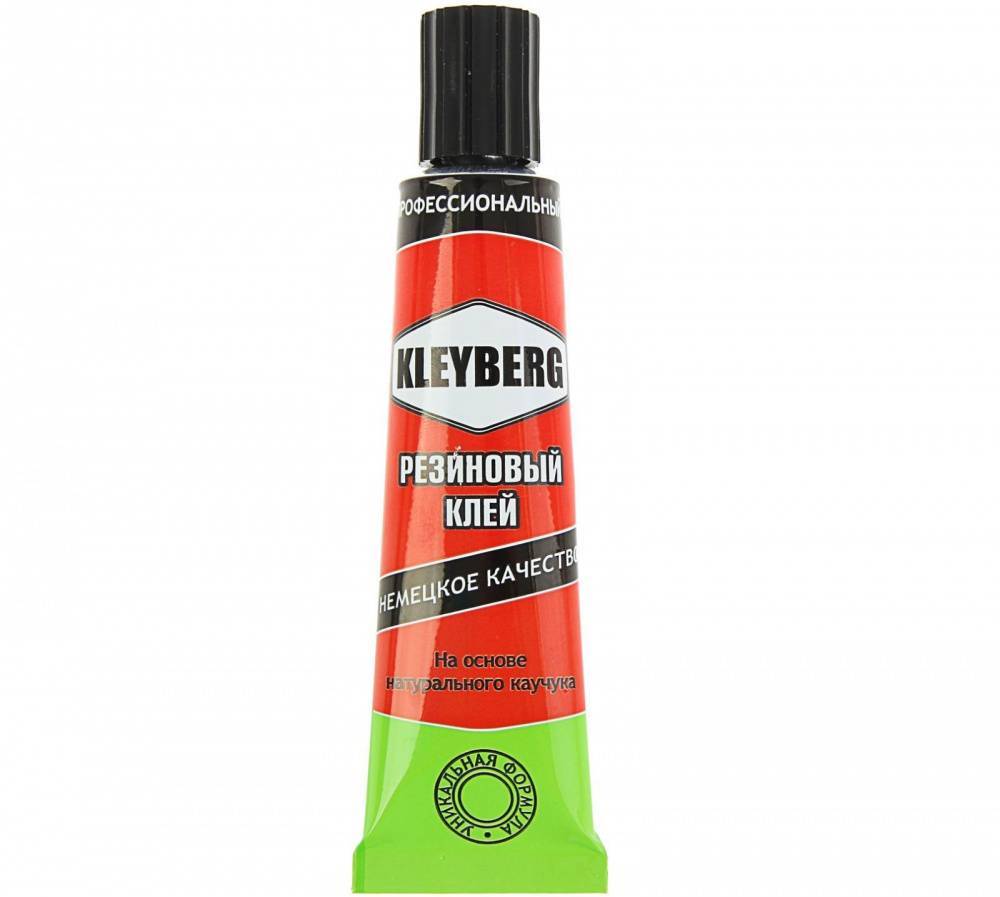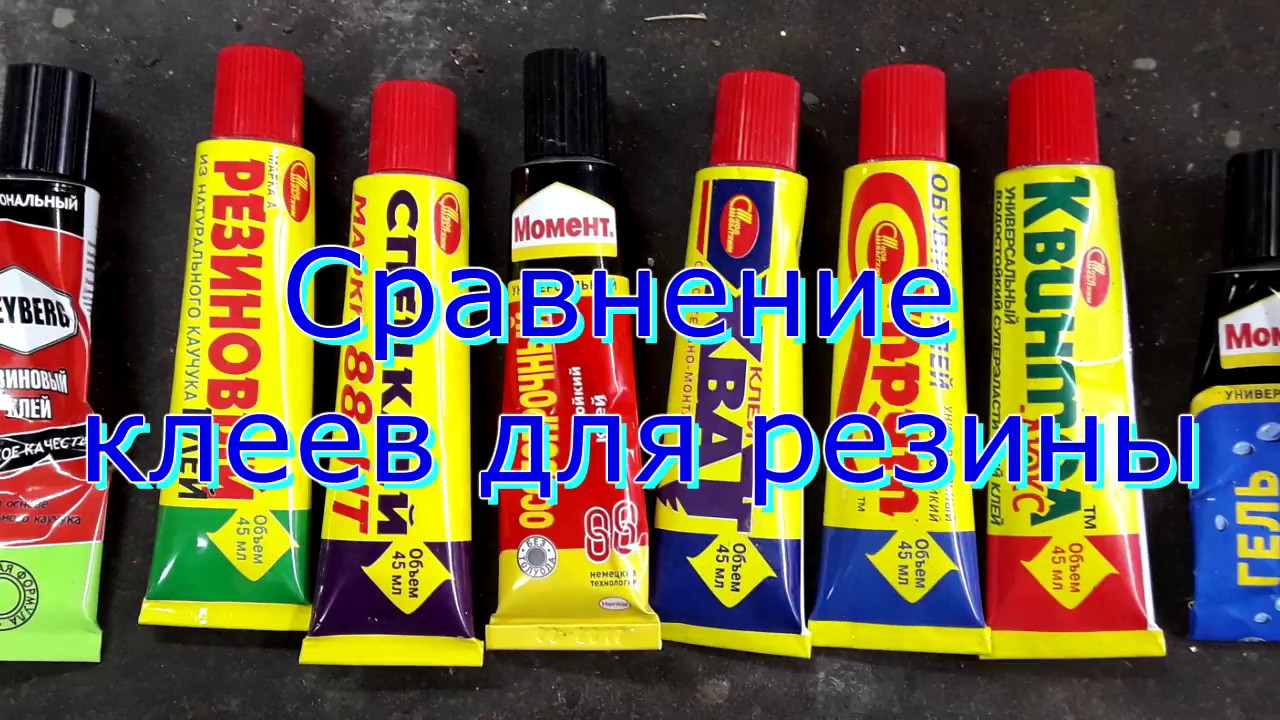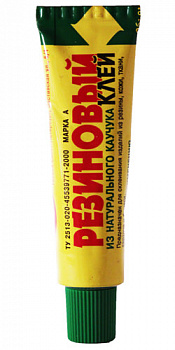Technology for working with glue for rubber
Subtleties of the process
Works using rubber glue must not be carried out in rooms where the temperature is below +5 degrees Celsius.
Surface preparation
To increase the efficiency of joining parts, before applying the adhesive, their surfaces are prepared. Extraneous inclusions are removed from it, for example, dust, dirt. Traces of moisture, oils and grease. Immediately before applying the glue, it is advisable to treat the surface with an abrasive paper. This will increase the adhesion of the parts to each other. A soft, lint-free cloth is sufficient to remove foreign objects, while degreasing liquids such as acetone can be used to remove grease and oil stains.
Adhesive application
To apply the composition, you can use a brush, if the mixture is thick, then you can use a spatula, its width and shape must be selected in place. The layer is applied at least 2 millimeters thick. The thickness of the applied layer is determined by which parts are to be joined. So, when repairing shoes or a rubber boat, it is permissible to apply an adhesive layer with a thickness of 1 mm. In this case, a layer of gauze is placed on the glue and press it with a spatula. Gauze acts as a reinforcing element. After a while, usually 15 - 20 minutes, apply a layer of glue again. To improve the adhesive bond, it is recommended to place the parts under the load and leave for several hours. Excess glue must be removed. The maximum bonding effect will be achieved after 24 to 48 hours.
Composition and application of glue for rubber
Rubber glue is a solvent in which rubber is dissolved. Such a composition presents great opportunities for creating adhesive joints. In addition, rubber-based glue guarantees that the seam between the parts will be elastic and therefore one of its areas of application is the processing of elastic materials.
Chlorine-containing compounds are most often used as rubber solvents; in addition, the use of aromatic hydrocarbons is permissible. But these substances are toxic, and their use is not always safe and therefore they are used in minimal quantities. Mostly they use ethyl acetate (ethyl ester of acetic acid) and nefras (refined products - gasoline, diesel fuel, etc.)
To reduce the risk of fire and reduce toxicity, adhesives and latex containing water. But the glue made using this technology is made with less adhesion.
Various resins and low molecular weight polystyrene can be added to the adhesives. These additives increase the strength of the glue line. It should be noted that the addition of more resins and polystyrene can lead to a loss of elasticity.
Various substances are used for vulcanization, their choice is due to the parameters of the selected rubber. Sulfur and metal oxides are most often used; amines can be used as agents during cold vulcanization.
In the production of adhesives, mineral oils are used, which play the role of plasticizers. Ethanol stabilizes all processes. It is designed to prevent getting the gel. Carbon black acts as a filler.
The above substances are part of any glue for gluing rubber, but each manufacturer has its own recipe and I must say that most of the recipes are kept in strict confidence.
The strength of the seam obtained by gluing rubber parts, as a rule, is greater than the strength of the rubber itself. For gluing rubber, technologists select glue that is close in composition to the substances to be glued.The universal glue is made on the basis of polyurethane. It allows you to connect different types of rubber together. For gluing leather and fabrics, water-dispersion glue is often used.
Among consumers, such formulations as are especially popular:
- Moment glue;
- 88 and its derivatives;
- Adhesives No. 3125 and No. 3126
The use of rubber glue of these brands is permissible both in everyday life and in industry.
Selection and technology of working with glue for rubber
For the repair or manufacture of products, it is necessary to select high-quality rubber glue. The more flexible the finished structure is, the more elastic the composition should be.
It is also important to take into account the humidity and operating temperatures of the product, the subsequent load, the structure of the materials (hard, soft, porous). Rubber-based glue should not harm the base material, show chemical aggressiveness to it
Subtleties of the process
To reliably glue two surfaces or repair a defect, you need to make sure that the consistency of the glue is optimal. It usually thickens when stored improperly or when it expires. If in the second case it is better to throw out the composition, then in the first case you can dilute it a little. How to dissolve too thick glue? Nephras or benzene are usually suitable and are added until smooth.
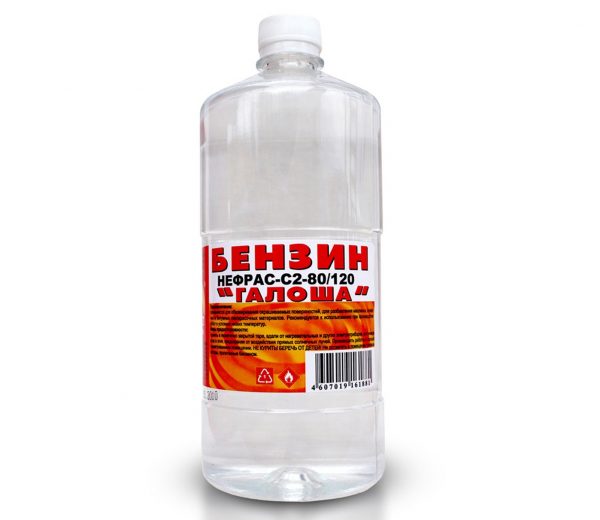
Other helpful tips when using glue:
- the temperature in the room should not fall below +5 degrees, otherwise the speed of solidification of the composition will sharply decrease, as well as the quality of the glue line;
- rubber compounds are flammable, work with them is permissible only with careful observance of fire safety rules (it is forbidden to be near any sources of fire);
- deviate from the manufacturer's instructions, it is impossible to reduce the holding time of the glue seam before operation;
- for hot gluing, it is most convenient to use a building hair dryer, which very quickly heats the glue to the required limit;
- when hot gluing, harmful vapors are released intensively, so work can only be done with good ventilation and wearing a respirator.
Surface preparation
When preparing before gluing, you need to remove any dirt from the products. It is recommended to sand smooth materials (sandpaper), this will help to enhance the adhesion of the glue to the base. After that, both parts must be degreased before gluing, for this they must be wiped with alcohol, acetone or another rapidly evaporating liquid. Surfaces must be completely dry before work.
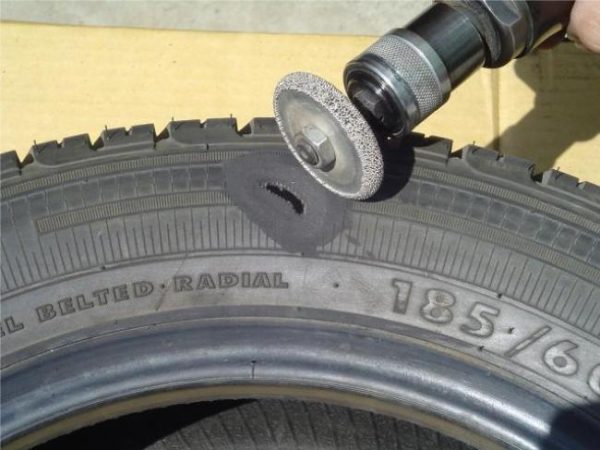
Adhesive application
Thick adhesives are applied with a small spatula, thinner ones - with a brush. The thickness of the adhesive layer is about 2 mm. After applying it on 2 layers, the parts are immediately pressed against each other, or the glue is heated or allowed to dry a little in the air - depending on the manufacturer's recommendations.
When repairing a boat, a thinner adhesive layer (1 mm) is made, then a piece of gauze is applied, another layer is applied, and only then a patch is attached. The glue that has come out is immediately removed with a knife, a spatula. The product is kept for 1-2 days or more, preferably in a vice or under a press.
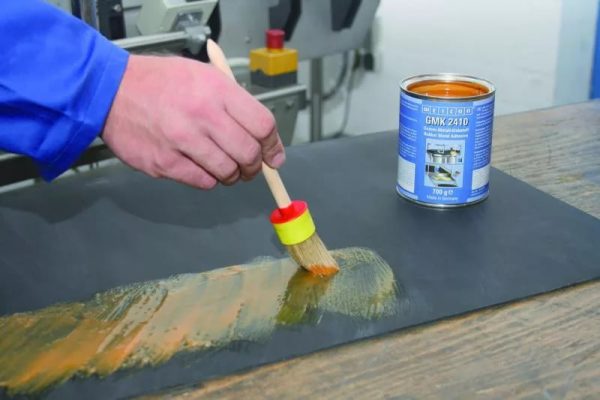
Adhesive technology
The algorithm for applying the glue is as follows:
- 1. The surfaces to be bonded must be prepared for joining. To do this, they remove traces of dirt, burrs, chips, peeling old paint and other foreign objects that can impair adhesion. If necessary, use sandpaper or a sander.
- 2. The prepared surface is degreased with any suitable liquid and dried thoroughly.
- 3. The glue is stirred until a homogeneous mass is formed, since it may thicken slightly during long-term storage.
- 4. Apply the substance to both surfaces to be joined, and then allow them to dry for 10-15 minutes. After that, a second layer is applied and dried for 2-3 minutes.
- 5. Then you can connect the surfaces as needed. It is best to place them under a press for a few hours to increase adhesion.
- 6. Then the press is removed and the glue is allowed to freeze completely, which will take 1-2 days.
As you can see from the step-by-step instructions, the sequence of actions is very simple and can be carried out right in the apartment. It is only necessary to comply with safety requirements, in particular, to work in protective gloves and do not allow glue to get into the eyes and food. It is also worth working only in well-ventilated rooms or rooms with forced ventilation. The adhesive is suitable for bonding rubber to metal, wood, glass, leather, concrete. With its help, you can carry out a huge number of operations that are not available for other models.
You need to purchase the substance only at the points of official sale in order to protect yourself from getting on counterfeit products. The price of 88 NP glue is approximately 300-350 rubles per kilogram. For household needs, there are special disposable tubes costing 50-70 rubles, which can sometimes be bought in large supermarkets. And it is best for manufacturers to make large wholesale deals in order to save on delivery and get a discount for buying a large batch at once.
Useful Tips
Recommendations of experts will help to qualitatively glue the surfaces:
- Some formulations thicken with prolonged storage. There is no universal diluent. To avoid difficulties, check the expiration date upon purchase.
- The temperature in the room where the work is carried out should not be lower than + 5 ° C.
- Before gluing, the surfaces must be cleaned of dust, dirt, degreased and thoroughly dried.
- The adhesion properties of the material will increase significantly if they are cleaned with sandpaper before applying the mixture.
- First you need to sand the surface (sandpaper) and only then degrease.
- The best option for degreasing is a volatile solvent such as gasoline or acetone.
- The composition should be applied with a brush, and if it is thick, then with a spatula.
- The minimum adhesive layer thickness is 2 mm.
- When repairing shoes and boats, a 1 mm layer should be applied to the previously sanded surface. After that, put a piece of gauze, press it with a spatula and reapply the glue, and only then, firmly press the surfaces to be joined together.
- Any stains and excess product must be removed immediately with a spatula or knife.
- Hold the bonded area under pressure (load) for at least a few hours.
Low humidity in the room slows down the drying of the adhesive. A high-quality product sets after 30 minutes, the final solidification occurs after about 48 hours.
Often, during the repair process, you have to glue dissimilar materials, for example, plastic and metal products, rubber and iron parts. For this purpose, a special glue for rubber and metal is perfect - a kind of superglue that has excellent performance characteristics.
Instructions for use
- Preparation of substrates before gluing. The surfaces must be cleaned of dirt, the metal must be abraded, then degreased with gasoline or acetone. In order for the glue to set faster, the parts can be additionally processed with sandpaper before degreasing.
- Warming up surfaces. Hot working technology involves heating surfaces to the required temperature, which can be done with a construction hairdryer.
- Application of the substance. If rubber is attached to plastic, the cold method is chosen, then the rubber surface is treated with glue, it dries for 15-20 minutes, then both surfaces are coated. The thickness of the glue depends on the type and brand, this information is indicated by the manufacturer on the label. On average, the layer should not be thinner than 2 mm.1 mm is allowed when gluing boats, repairing shoes. The mixture is applied with a brush, a thicker consistency - with a spatula. Both parts are tightly pressed against each other and held for several minutes, it is best to put under a press for a more secure fix. Excess glue is removed with a blunt part of a knife blade or a spatula.
Cold way
Bonding is carried out at natural ambient temperature, but not lower than +5 ° C. First, one part is lubricated, dries up for 20 minutes, and then the procedure is repeated for both fragments. The parts are pressed with effort for 2-3 minutes, while the seam will gain maximum strength no earlier than after 1-2 days.
Hot glue
The gluing takes only a few minutes, but it is necessary to ensure that the surface is heated up to t = + 70… + 160 ° C. After, the bases are coated with glue and connected.
Views
The distribution of adhesives by type is carried out according to two distinctive features: by the volume of the dry residue and by the composition of the rubber itself. According to GOST, the volume of dry residue can be from 6-8% to 8-12%. Glue, if it contains from 6 to 8% of the dry residue, is known as grade A (more elastic composition), and when the indicator is from 8 to 12%, then it is glue released under the brand B.
The most used classification is according to the characteristics of the rubber contained in it.

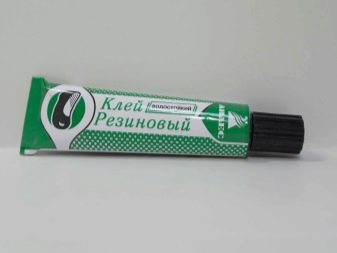
The most common types of rubber products are:
- Natural rubber compounds. This substance contains sulfur. This glue is chosen for gluing parts made of cardboard, leather or fabric. Suitable for carpet.
- Chloroprene composition. For the implementation of vulcanization, divalent metal oxides are included in it. The composition is very good in terms of connecting qualities, and therefore it is chosen for gluing metal and other elements.
- Adhesive with the inclusion of nitrile butadiene rubber. Sulfur also acts as a vulcanizing element here, but only with the addition of thiuram. This adhesive is water resistant and is selected for a variety of popular materials.
- Silicone glue. Its hardening occurs only under the influence of tetrabutoxylane. It is rarely used, as it can only glue homogeneous rubber.
- Styrene butadiene adhesive. It has a weak gluing ability and therefore is bought only for production, for example, for the production of scotch tape. Other artificial rubbers can also be the basis of this kind of glue, but their use is limited.
Adhesives for rubber are divided according to their intended purpose: for industrial and home use (for gluing various coatings at home). Industrial glue is used in manufacturing, it is produced in huge volumes, and it is applied to coatings using special tools.
Such compositions are glue 88, 88 H and 88 CA. They are found in the construction industry - for the installation of various finishing surfaces, in the automotive industry - for gluing rubber products, in the production of furniture and any footwear. This product is suitable for gluing rubber and gluing it to metals, paper, wood.
Quick-drying universal glue "Moment-1". It is better to choose it for gluing rubber, wood, metals, leather and felt, plastic and glass, as well as ceramics. This high-strength composition is very toxic and quite flammable, therefore it can be used only in air or in a room that is ventilated, while keeping the composition away from open flame.
It is applied in the thinnest layer on two completely dry elements, which are first of all cleaned and degreased, then they are kept for about 15-20 minutes until completely dry. After that, both surfaces are strongly pressed against each other for only 10-15 seconds.
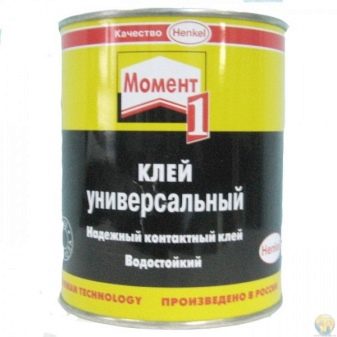
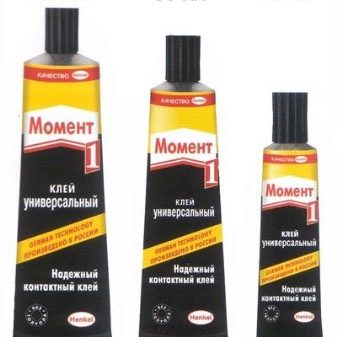
You can also often find such a type of rubber glue as liquid rubber - it is a transparent polyurethane glue-paste for repair work, surface protection and their high-quality waterproofing.This composition is distinguished by its resistance to wear and tear, flexibility, it completely fills the existing gaps, and is not afraid of temperature changes.
It is also worth mentioning the rubber adhesive sealant - this is a high-strength adhesive that is needed for high-quality repair of seals in doors and windows. It hardens very quickly, adheres perfectly porous and non-porous materials.
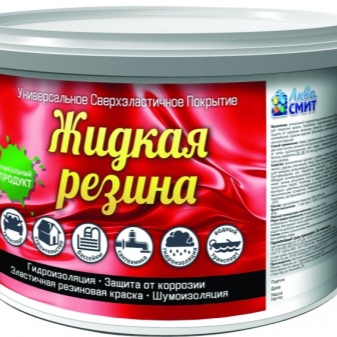

Instructions for use
Before use, any brand of product must be thoroughly mixed, giving homogeneity. How to use glue and what to dissolve, if thickened, is always indicated in the specific instructions for use. Most types of adhesives can be diluted with ethyl acetate up to 1: 1. How to dilute glue in the presence of organic solvents? This is xylene or toluene, in some cases gasoline is suitable. You can use a 1: 1 mixture of Kalosha solvent and gasoline.
Before gluing, surfaces should be cleaned of dirt, dust, degreased and cleaned with sandpaper. There are two ways to use it:
- Hot. Apply the product in a thin layer, dry for half an hour. Then fold the surfaces and warm up at +90 degrees for 10 minutes. Then wait at least 3 - 5 hours before using the product.
- Cold. Apply a thin layer of glue, dry for 15 minutes, then apply another layer. Press the parts down, dry them for 24 hours at room temperature.
It should be noted that on porous materials, a primer must be applied before gluing. What it is and what brand to choose is indicated in the instructions. Priming will help reduce the absorbency of the adhesive.
Glue 88-NP
Advantages of 88-NP glue:
- Heat resistance - glue 88-NP can be used in any climatic conditions at temperatures from -50 to +70 С
- Moisture resistance - fastening with 88-NP glue is more resistant to the effects of fresh and sea water in natural conditions.
- Glue 88-NP does not have the ability to form toxic compounds in the air and wastewater in the presence of other substances or factors.
Scope of glue 88-NP:
- Automotive industry: for fixing headliners, fixing interior trim and door gaskets, assembling seats (foam and upholstery);
- Furniture industry: for fastening fabrics, joining foam parts, assembling individual pieces of furniture;
- Shoe industry: for fastening soles, glue fasteners, shoe uppers, duplicating;
- Construction industry: for decorative coatings, polystyrene, carpets, glass, wood and finishing materials.
Directions for use:
- Stir the glue 88-NP thoroughly before use.
- Thoroughly clean the surface of the product from dirt, degrease with gasoline or acetone and dry.
- Grease the surfaces to be glued with a thin layer of 88-NP glue, air dry for 10-15 minutes, apply a second layer of glue - dry for 3 minutes.
- Press the surfaces lubricated with 88-NP glue to each other under light load for 2-3 hours.
- Operate the product after 24-48 hours.
Most popular brands
Also, the choice can be facilitated by studying popular types of adhesives that serve as means, than you can easily glue rubber with rubber tightly, they are also applicable for other materials. There are several brands:
-
Glue 88 N, a domestic manufacturer, creates a reliable and durable adhesion between rubber and other materials. Can be diluted with benzene, to thicken it is needed;
-
Glue Moment is a good option for working at home, it gives an excellent seam quality, but it dries quickly, as a result, the tube itself has to be thrown out, even when closed it quickly fails;
-
Adhesive mortar 4508 the resulting joint is distinguished by its water resistance and elasticity. Used for textile products, rubberized materials, suitable for boats, can be used for gluing plastic and PVC;
-
Plasti Dip is a rubber-added colorant used on automotive parts;
-
Rubber cement is often chosen by shoe specialists to bond the leather, and the seam can be pulled apart even after hardening, and is convenient for working with large items;
-
The radical is usually used to work with boats, due to its high resistance to water, while it is not afraid of even sea water, it is black;
-
Glue 88 CA is a universal composition suitable for gluing concrete, metal, rubber, wood, foam and foam products.
Quality is regulated by GOST
The parameters of rubber glue, composition, areas of use, safety measures are regulated in GOST 2199-78. It normalizes the basic parameters and all manufacturers of these products who produce them with us must reckon with them. By the way, all adhesives imported from abroad must meet the requirements of this document. In addition, they must contain papers that confirm their safety and quality.
Nevertheless, at the firms - the manufacturer of the glue compositions, high technology equipment is widely used, mainly operating under the control of today's computer technology. In other words, human participation is minimized and, similarly, the anthropogenic factor that often affects product quality is eliminated.
When carrying out acceptance tests, the manufacturer proves the complete compliance of the finished adhesive with the requirements of the documentation of the regulatory framework or the requirements of the customer. If there is a complete or selective non-conformity, then the product is recognized as substandard and sent for processing or processing.
If you find an error, please select a piece of text and press Ctrl + Enter.
TOP 6 best glue for rubber
There are several factors to consider when choosing the best rubber adhesive for a particular situation:
- Material characteristics (thickness, flexibility)
- Conditions under which gluing will be performed
- Product operating conditions (temperature, load, vibration exposure)
Glue 88 (CA, H)
The 88 series of adhesives are available in a variety of media. For a situation in which you need to glue rubber to rubber, grades 88 CA and 88 H are suitable. Rubber glue 88 CA is easy to use for repairs. It is used both in everyday situations and in industrial conditions (construction, automotive, footwear industries). 88 N glue is the most durable rubber glue of all the products in this line, but it requires a longer exposure time before use than 88 CA brand.
Advantages of adhesives 88 CA, 88 N:
- large exposure temperature range (from -40 ° C to + 50 ° C);
- water resistance;
- long residual stickiness;
- elasticity of the seam;
- fast adhesion;
- lack of toxic substances.
Glue 4508
This rubber adhesive contains a solution of a rubber compound. Makrka 4508 has proven itself to be excellent in the repair of shoes, special protection suits, fishing suits, boats. Glues any cameras tightly. At the same time, it does not require hot processing, since vulcanization occurs during the operation of the technical device.
Of the advantages of the 4508 brand, the following are worth highlighting:
- high water resistance;
- increased elasticity;
- vibration resistance;
- good stickiness;
- creating a strong seam (when using hardeners, the seam strength is even higher)
- heat resistance (up to + 50 ° C)
Rubber adhesive grade A
This natural rubber glue is easy to use and is suitable for bonding almost any surface. The neat seam and cleanliness of the surface after gluing allows this glue to be used in decorative and design work. In small repair and construction works it is used as an elastic sealant.
Advantages of using this brand of glue:
- elasticity of the seam;
- resistance to weathering;
- resistance to oily liquids and gasoline;
- does not leave marks on the surface;
- does not require preliminary degreasing;
- dries quickly;
- transparent.
Moment Rubber
This product from the well-known Moment line is suitable for gluing rubber materials of any hardness and porosity (including foam). Creates a strong and reliable grip that allows you to glue rubber to rubber tightly.
Possesses the following positive characteristics:
- elastic;
- waterproof;
- resistant to a wide range of influencing temperatures (from -30 ° C to + 100 ° C);
- lasting.
Radical
Radical is a particularly durable repair agent. In addition to everyday situations, it is used for gluing wetsuits, rubber boats and kayaks.
Pros of using Radical glue in repair:
- glued surfaces withstand high pressure and heavy loads;
- resistant to water (fresh and salt);
- wide range of operating temperatures (from -40 ° C to + 70 ° C).
Kernil
> Each adhesive has its own characteristics and application. Therefore, the answer to the question of which glue for rubber is the best is obvious: the one that is selected taking into account the type of product and its operating conditions.
Manufacturers
The Russian user is familiar with the Moment glue. This is really the best option for home use. It has a wide scope of use and allows you to easily solve most of the problems that may arise in everyday life. The only drawback is the quick curing of the glue, which makes the tube disposable. Even after tightly closing, the glue in the tube will still harden and become unusable for further use.
The Novbytkhim company from St. Petersburg has an extensive production of household chemicals and paint-and-lacquer products. Among such a wide assortment, there is also a special rubber glue of the 88-NT brand.
Ecoline produces a range of rubber compounds. Among such an assortment, it is easy to find the right option for any job. Products are produced in various volumes, which is convenient for the user. Brands from this manufacturer are often purchased for various industries.
Adhesive selection
Which glue is better to use, what are the selection criteria? If you need to firmly glue metal to rubber, you should look for a product with enhanced adhesion, which gives a reliable seam, while elastic
It is also important to consider a number of factors:
- humidity and temperature in the rooms where the gluing will be carried out, and then the operation of the product;
- load on the surfaces to be glued;
- the need for high aesthetic properties of the finished product;
- the degree of chemical aggressiveness of the adhesive, taking into account the type of metal.
When buying, it is important to clarify in the instructions or on the packaging that the manufacturer guarantees the suitability of the composition for rubber and metals, alloys. Universal means are far from always suitable for such a complex joint, as well as for joining other dissimilar materials.
After drying, the seam should not flake off from the base, must be heat-resistant and not change the strength under the action of low temperatures.
For cars, it is often advised to buy products such as "liquid rubber". They can perfectly glue rubber surfaces, as if becoming part of them, therefore they are invisible from the outside. The water resistance of the glue is another important point when choosing; this property is required by almost every user, especially a car owner. If necessary, you can buy glue that will allow you to operate the parts even under water.
When joining rubber and metal, it is important to exclude corrosion, therefore, there is always a note on the safety of the composition on a high-quality glue.A separate type of adhesives is considered to be means for silicone rubber, which is soft, pliable.
On the tube of such glue there is an inscription “for elastic materials”.

The best brands for bonding
How to glue metal or other complex materials to rubber? For this purpose, it is worth purchasing only proven formulations:
- 88CA. Resin glue on organic solvents, contains phenol-formaldehyde resin, nefras, ethyl acetate. Perfectly fits both painted material and concrete, glass, wood, suitable for dissimilar substrates. The composition is waterproof, does not flake off from the action of moisture, after drying it does not give off toxic fumes. Does not interact with metal, therefore does not provoke corrosion.
- U425-3. The properties are similar to those described above, since they have a similar composition. It is used for bonding with subsequent vulcanization, if required.
- 4NB-UV. The glue is oil-resistant, waterproof, but withstands heating only up to +60 degrees, while it is frost-resistant - it is not damaged from freezing to -40 degrees. They can glue rubber, rubber-fabric materials, metal. Such a composition forms a very elastic seam, has a residual stickiness. It is ideal for repairing various rubber products, boats, chemical protection suits.
- Radical. This glue can serve even in seawater, does not deteriorate from the action of salts and alkalis, therefore it is popular among fishermen (it is used to repair any boats).
- The moment is rubber. Suitable for hard and foamed rubber, provides high strength, resistance to water and oils, elasticity of the glue line.
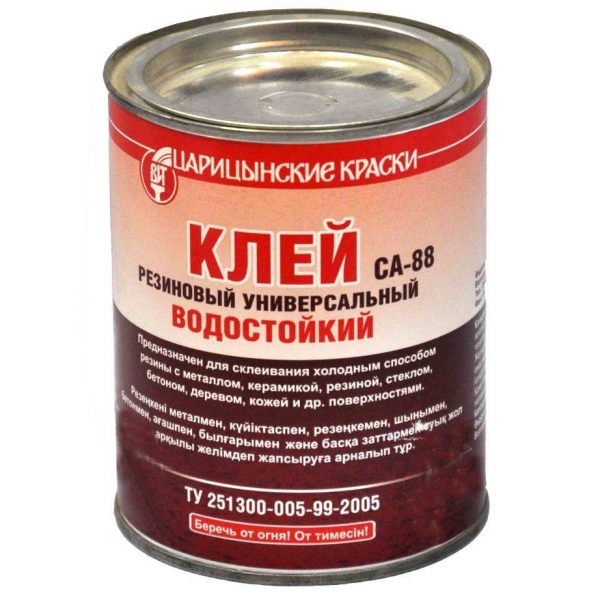
Also, for complex surfaces, adhesives such as Super-NN, Rogneda, Loctite Super Fast are often used. Some users make rubber adhesives on their own in order to save money. To do this, soft rubber is crushed and filled with aviation gasoline to completely cover the mass. After 2-3 days, the liquid is filtered off. After keeping it warm for another couple of days, the glue will be ready.
Composition of high strength rubber adhesive
The rubber glue is based on natural rubber. Industrial and household compounds are on sale. They can have a liquid or viscous consistency. There are also two-component products. However, the base of each substance is considered to be the dissolved rubber.
The following components can act as solvents:
- Chlorine-based substances or aromatic hydrocarbons. The components are characterized by toxicity, therefore they are introduced into the glue in a minimal volume.
- Latex with water. This compound is characterized by low toxicity and low flammability. However, it does not adhere well enough to the base.
- Ethyl acetate with nefras. The chemical formula of the substance includes petroleum products and acetic acid ester.
- Resin with polystyrene. The substance makes the layer durable. With a large amount of additives, the seam becomes less elastic.
- Plasticizers. Phthalates and lanolin can play their role. Also, the glue contains mineral oils or carboxylic acids in the form of esters.
- Sulfur, metal oxides, amines. These components are responsible for vulcanization. The choice of additives depends on the properties of the rubber.
- Stabilizers. These ingredients help prevent the glue from transforming into gel. Usually diethylamine or ethanol is used.
Each manufacturer offers a unique rubber glue formula. It is developed depending on the characteristics of the fixed surfaces.
How to glue PVC: an overview of compositions for different types of base
There are several types of compounds for gluing PVC products. Adhesive for PVC is chosen depending on the type of material - it can be fabric, finishing materials, film, communication systems (durable and hard material).
There are types of glue according to their properties.
- Glue-fixer - provides exclusively fixation of elements, but does not glue.It is used for laying floor coverings, the absence of a strong seam simplifies the dismantling of fragments or the entire cover.
- Reactive adhesives are effective when laying heavy rubber elements or joining large parts.
- Contact adhesive provides the most durable seam and crystallizes quickly enough.
Laying tiles, wall panels
Surface cladding with PVC panels requires high elasticity of the adhesive, resistance to moisture and temperature extremes. If the surface is smooth, the glue is applied directly to it; otherwise, a reinforcing mesh should be applied; glue alone will not be possible.
For the installation of plastic panels, a special glue "Liquid nails" is on sale, the products of the "Titan" company and the long-established "Moment Montage" are no less popular.
PVC tiles are laid in a similar way, but the purpose of the room plays an important role here. Some masters neglect the choice of glue according to the type of room, which leads to a poor-quality result - the fragments "move out", lag behind the base.
Dealing with the purpose is quite simple: if high permeability is expected, it is better to choose an epoxy or polyurethane composition, for the house the main factor will be water resistance and toxicity. Acrylic and polychloroprene adhesives have the lowest emission of volatile compounds. Compositions are presented in a wide range, used for gluing to a varnished base, fastening cork products, including finishing walls and floors.
PVC materials
PVC fabric is used to make boats, camping tents or similar products. During operation, the material may be damaged, and the composition included in the repair kit is only enough for a minimal cut.
To glue the fabric, various thermoplastic compounds, silicone threads are used. After application, the composition is gently heated without damaging the material itself. Adhesive for PVC fabric is spread over the area, then subjected to high temperature using an industrial hair dryer, after which the composition "welds" the parts of the fabric. The most effective method is to apply patches of a similar material and use a suitable adhesive.
Film
PVC film is used on an industrial scale - for cladding furniture, doors, swimming pools. In a particular case, there may be a need to repair or restore part of the element: to attach or replace the peeling material.
For such purposes, it is best to purchase a two-component adhesive for PVC film with a suitable heat resistance index.
Not all compounds can withstand exposure to direct sunlight (this is important in the case of pool finishing)
When repairing interior doors, the temperature regime will be in second place, it is more important to pay attention to the degree of moisture drainage


